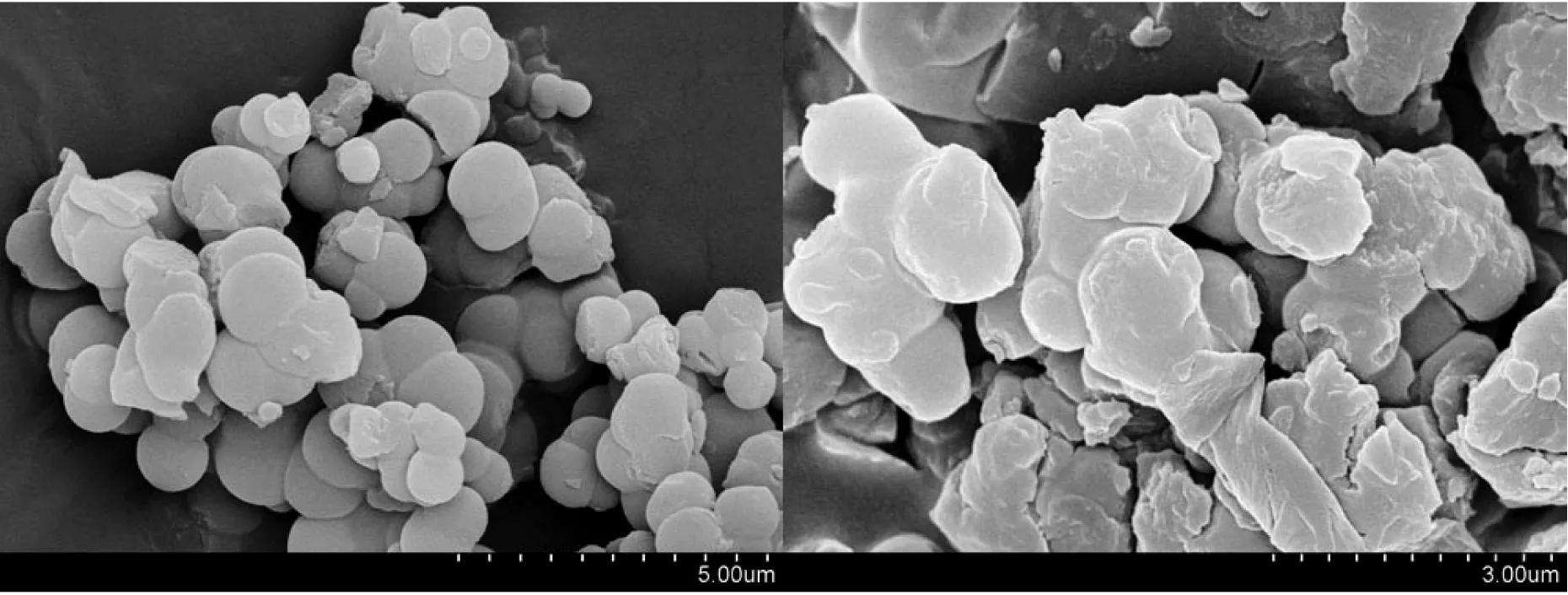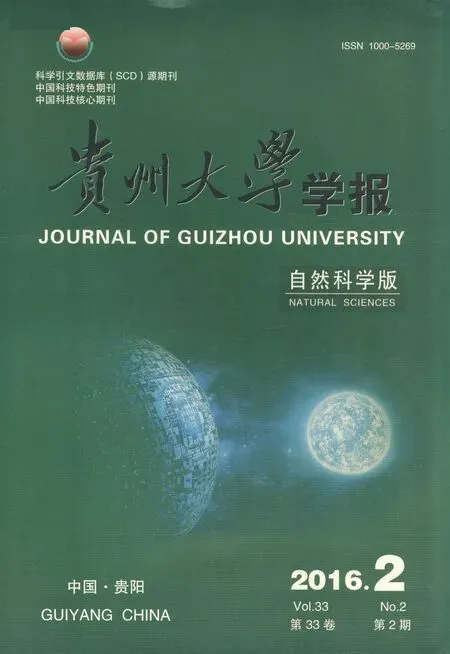Direct synthesis of cucurbit[6]uril-anchored polyacrylic acid
2016-09-24CHENPengGAORuihanFANYingXIAOBoXUESaifengZHUQianjiangTAOZhu
CHEN Peng, GAO Ruihan, FAN Ying, XIAO Bo,XUE Saifeng, ZHU Qianjiang,TAO Zhu
(Key Laboratory of Macrocyclic and Supramolecular Chemistry of Guizhou Province,Guizhou University, Guiyang 550025, China)
Direct synthesis of cucurbit[6]uril-anchored polyacrylic acid
CHEN Peng, GAO Ruihan, FAN Ying, XIAO Bo,XUE Saifeng, ZHU Qianjiang*,TAO Zhu
(Key Laboratory of Macrocyclic and Supramolecular Chemistry of Guizhou Province,Guizhou University, Guiyang 550025, China)
A one-pot strategy, empioying ammonium persulfate (APS) as both initiator and oxidant, has been devised to synthesize water-soluble cucurbit[6]uril-anchored (Q[6]-anchored) acrylic acid (AA) polymers in high yields. The obtained Q[6]-anchored polyacrylic acid (PAA) has been characterized by1H NMR,13C NMR, 2D NMR, FTIR, GPC, and SEM measurements. Experimental results have shown that PAA chains could be grafted onto Q[6] in a controlled manner through an in situ radical polymerization approach.
one-pot strategy; cucurbit[6]uril; acrylic acid; cucurbit[6]uril-anchored polyacrylic acids
Unlike for other host molecules, such as calixarenes and cyclodextrins, the chemical stability of cucurbit[n]urils (Q[n]s) has limited their practical applications due to the difficulty in introducing functional groups on their surfaces to make them reactive, and to increase their solubility. Kim and co-workers made a great breakthrough in 2003 by the direct oxidation of Q[n]s with K2S2O8in water to yield perhydroxycucurbit[n]urils ((OH)2nQ[n]s).1Since then great achievements have been made in functionalized-Q[n] chemistry, in particular, Q[n]-based polymers. For example, (HO)12Q[6] can be grafted onto silica gel as a hydrophilic-interaction-based chromatographic stationary phase.2(HO)12Q[6] can also be used to synthesize polymer nanocapsules with a noncovalently tailorable surface. Such Q[6]-based polymers could serve as efficient new vehicles for the delivery of hydrophobic drugs,3in preserving imparted fluorescence, analysis of membrane proteins, selective metal ion extraction, and so on. Generally, to synthesize Q[n]-based polymers, Q[n]s must first be oxidized to ((OH)2nQ[n]s), and then functionalized with various polymerizable groups.4However, the direct oxidation of Q[n]s appears to be efficient only for smaller Q[n]s, such as Q[5] and Q[6] (yields of 42 and 45%, respectively), and not for the larger Q[n]s, such as Q[7] and Q[8] (ca. 5%), or partially alkyl-substituted Q[n]s. The cause of the low yields in these reactions is still unclear.
In 2013, Su and co-workers demonstrated a one-pot, direct method for the preparation of Q[6]-anchored acrylamide polymers, that is applicable for monomers used in radical polymerization in aqueous solution.5The method does not require the isolation of (OH)2nQ[n]s, since the oxidation and the polymerization reactions occur in the same reaction system. Our group further confirmed the efficiency of this strategy for various Q[n]s, not only for the smaller Q[5] and Q[6], but also for the larger Q[7] and Q[8], and in particular, for partially alkyl-substituted Q[n]s for the preparation of Q[n]-anchored acrylamide polymers in high yields (50~70%).6The experimental results showed a generality for various monomers, which included acrylamide, and 4-vinylbenzylamine.5Using acrylic acid (AA) as monomer, cucurbit[5]uril-anchored polyacrylic acid (Q[5]-anchored PAA) was synthesized, which displayed selective absorption of some volatile compounds, particularly methanol.7More recently, the one-pot strategy has been employed to synthesize a series of water-soluble cucurbit[7]uril-anchored polyacrylic acids (Q[7]-anchored PAAs) in the presence of an ammonium persulfate. The Q[7]-anchored PAAs could be further esterified with 2-naphthol to yield water-insoluble derivatives, which could serve as stationary phases for the absorption of basic dyes, especially neutral red.8Thus, direct synthesis of Q[n]-anchored functional polymers by the one-pot strategy should provided a high capacity utilization method of Q[n] in polymer chemistry. Herein, we introduce the water-soluble Q[6]-anchored polyacrylic acids (Q[6]-anchored PAAs), which show a typical microspherical structure.
Scheme 1. Synthesis of Q[6]-PAA by a radical polymerization mechanism

1 Experimental Section
Chemicals: Q[6] was prepared according to methods previously reported in the literature.9,10Ammonium persulfate (APS, AR) and acrylic acid (AA, AR) were obtained from Aladdin Industrial Corporation (Naoqiao Town, Fengxian Shanghai, China).
Synthesis of Q[6]-anchored PAA: As a typical example, Q[6]-PAA-2 was synthesized by combining Q[6] (0.017 mol/L solution in distilled water, 50 mL, 0.85 mmol) and APS (1.16 g, 5.1 mmol). The mixture was stirred with a small magnetic stir bar under an inert nitrogen atmosphere and heated to 80 ℃ in a water bath. After thermal equilibrium had been reached and N2had been bubbled through the solution for 1 h, a 0.8 mol/L aqueous solution of AA (12 mL, 9.6 mmol) was added by dropwise. After the addition of AA and reaction for 1 h, further APS (0.2 g) was added to the solution. After reaction for a further 0.5 h, further 0.8 mol/L aqueous acrylic acid solution (8 mL, 6.4 mmol) was added. After stirring the reaction mixture for a further 8 h, it was cooled to room temperature. The resulting precipitate (salts formed during reaction) was removed by filtration. The filtrate was purified by dialysis (MWCO 2000) against water for 24 h to yield a polymer solution, and then concentrated to a volume of 2 mL on a rotary evaporator. The product was precipitated from the concentrated solution by the addition of acetone, and purified by three dissolution precipitation cycles. The white precipitate was washed three times with acetone. It was then collected, immersed in acetone for 4 h, and then dried under reduced pressure at 40 ℃ for 48 h. The yield was about 60%. Other Q[6]-anchored polyacrylic acid samples were synthesized under similar conditions, but with varying feed masses of acrylic acid (yields 30~80%). The detailed synthetic conditions are listed in Table 1.
Characterization: All NMR spectra, including those for titration experiments, were recorded at 20 ℃ on a VARIAN INOVA-400 spectrometer. D2O was used as a field-frequency lock, and the observed chemical shifts are reported in parts per million (ppm) relative to an internal standard (TMS at 0.0 ppm).
Scanning electron microscopy (SEM) images were recorded on a Hitachi S-4800 II field-emission instrument. Samples were dispersed in acetone immobilized on silicon wafers, and allowed to dry under reduced pressure at 40 ℃ for several hours.
Gel permeation chromatography (GPC) measurements were carried out in 0.3M sodium nitrate solution as eluent (pH 6.8, 1mL/min) at 45 ℃ using a PL-GPC50 from Agilent with a refractive index detector. A 6.75 mg/mL solution of glucan (Mw=2.73 × 106) was used as reference.
2 Results and Discussion
Characterization of Q[6]-anchored PAAs: Using a one-pot strategy, the most readily synthesized cucurbituril (Q[6]) was selected as the anchor. Acrylic acid (AA) was polymerized in the presence of ammonium persulfate (APS) as an initiator and oxidant to produce Q[6]-anchored polyacrylic acids (Q[6]-anchored PAAs). Four Q[6]-anchored PAAs obtained by free radical polymerization in aqueous solution in the presence of APS were selected as typical samples to illustrate their features of Q[6]-anchored PAAs (Table 1). The representative samples were synthesized with incrementally higher feed masses of acrylic acid as shown in Table 1. Generally, the weight-average molecular weight (Mw) increased with increases in the proportion of acrylic acid and the amount of APS used. In particular, When the feed mass ratio of Q[6] to acrylic acid reached 1∶80, the Mw of the Q[6]-anchored PAA showed a sharp increase, up to 7×105.

Tab.1 Feed compositions and typical features of Q[6]-PAA samples.
NMR of Q[6]-anchored PAAs: Figure 1 shows the1H NMR spectrum of the obtained Q[6]-PAA-2 polymer in D2O as a representative example. The relatively broad proton signals at1.1-2.3 ppm can be attributed to the methylene protons (Hf) and methine protons (He) of the PAA segment, respectively (see the inset in Figure 1). The cross-peaks at 2.44 and 4.11 ppm can be ascribed to protons (Hd) and methine protons (Hc) of the PAA moiety that bridges the Q[6] moieties and the PAA segment.

Fig.1 1H NMR spectrum of the Q[6]-PAA
The13C NMR spectrum of Q[6]-PAA-2 (Figure 2) shows a carbonyl carbon signal from PAA at 184ppm (1), and resonances of two different carbonyl carbons from grafted (2) and ungrafted (3) glycoluril moieties of the Q[6] unit in Q[6]-PAA-2 at 162 and 155ppm, respectively.

Fig.2 13C NMR spectrum of the Q[6]-PAA
Size and morphology of Q[6]-anchored polymers: the size and morphology of polymer aggregates are important factors for their applications. Here, the morphology of Q[6]-PAA-based aggregates was studied by SEM measurements.11-13An SEM micrograph of Q[6]-PAA-2 revealed an almost spherical morphology with particles of diameter of 800~1000 nm (Figure 5a). the above work on Q[6]-PAA demonstrated the feasibility and simplicity of the one-pot synthesis strategy, and the Q[6]-anchored PAA with reactive carboxyl groups could be further derivatized to give water-insoluble materials.8To this end, we esterified Q[6]-PAA-2 with cellulose to yield a water-insoluble Q[6]-PAA-2-(cellulose), which could be used as an absorptive materials. Figure 5b shows an SEM image of Q[6]-PAA-2-(cellulose). It is clearly evident that it has a more irregular morphology than that of Q[6]-PAA-2. The diameters of the particles are in the range 1000~1500 nm. This implies that the interaction of Q[6]-PAA-2 with cellulose is a liquid-solid process. Nevertheless, the formation mechanism of this morphology needs further study.

a bFig.5 SEM of aggregates of micrographs of (a) Q[6]-PAA-2, (b) Q[6]-PAA-2-(cellulose)
Conclusion
In summary, aggregates of Q[6]-anchored PAAs have been synthesized by a one-pot free radical polymerization strategy in the presence of APS as both an initiator and oxidant. The vesicle features of Q[6]-anchored PAAs might be used in drug delivery, preserving fluorescence, encapsulation and release of a fluorescent dye, and so on. Such materials could broaden the application of cellulose. Exploration of new properties of Q[6]-PAA-based polymers is ongoing.
References:
[1] Jon S Y, Selvapalam N, Oh D H, et al. Facile a synthesis of cucurbit[n]uril derivatives via direct functionalization: expanding utilization of cucurbit[n]uril[J]. Am. Chem. Soc, 2003(125): 10186-10187.
[2] Liu S M, Xu L, Wu C T, et al. Preparation and characterization of perhydroxyl-cucurbit[6]uril[J]. Talanta, 2004(64): 929-934.
[3] Park K M, Suh K, Jung H, et al. Cucurbituril-based nanoparticles: a new efficient vehicle for targeted intracellular delivery of hydrophobic drugs[J]. Chem. Commun, 2009, 71-73.
[4] Kim K, Selvapalam N, Ko Y H, et al. Functionalized cucurbiturils and their applications[J]. Chem. Soc. Rev, 2007(36): 267-279.
[5] Huang X L, Hu F L, Su H Q. Facile syntheses of cucurbit[6]uril-anchored polymers and their noncovalent modification[J]. Macromolecules, 2013(46): 1274-1282.
[6] Xiao B, Fan Y, Ji N N, et al. Direct syntheses of a series of cucurbit[n]uril-anchored polyacrylamides[J]. Supramol. Chem, 2015(27): 4-12.
[7] Xiao B, Fan Y, Gao R H, et al. Direct synthesis of cucurbit[5]uril-anchored polyacrylic acid microspheres and potential applications in selective sorption[J]. RSC Adv, 2015(5): 33809-33813.
[8] Gao R H, Fan Y, Xiao B, et al. Direct syntheses of cucurbit[7]uril-anchored polyacrylic acid microspheres and adsorption of basic dyes by the derivative[J]. RSC Adv, 2015(5): 65775-65779.
[9] Day A I, Arnold A P. Method for synthesis cucurbiturils[P]. WO0068232, 2000, 8.
[10]Kim J, Jung I S, Kim S Y, et al. New cucurbituril homologues: syntheses, isolation, characterization, and X-ray crystal structures of cucurbit[n]uril (n=5,7,and 8)[J]. Am. Chem. Soc, 2000(122): 540-541.
[11]Kim D, Kim E, Kim J, et al. Direct synthesis of polymer nanocapsules with a noncovalently tailorable surface[J]. Angew. Chem. Int. Ed, 2007(46): 3471-3474.
[12]Kim D, Kim E, Lee J, et al. Direct synthesis of polymer nanocapsules: self-assembly of polymer hollow spheres through irreversible covalent bond formation[J]. Am. Chem. Soc, 2010(132): 9908-9919.
[13]Kim E, Kim D, Jung H, et al. Innentitelbild: facile, template-free synthesis of stimuli-responsive polymer nanocapsules for targeted drug delivery[J]. Angew. Chem. Int. Ed, 2010(49): 4405-4408.
(责任编辑:王先桃)
1000-5269(2016)02-0027-04
10.15958/j.cnki.gdxbzrb.2016.02.07
2012-02-30
国家自然科学基金(编号:21272045, 51463004);中国教育部“春晖”计划(编号:Z2014093);贵州省科学与科技厅合作项目(编号:20157661)
陈鹏(1988-),男,在读硕士,研究方面:应用有机化学,超分子化学,Email:.
祝黔江,Email:zqjgzu@126.com.
六元瓜环桥连丙烯酸聚合物的直接合成
陈鹏,高瑞晗,范颖,肖勃,薛赛凤,祝黔江*,陶朱
(贵州大学 化学与化工学院,贵州 贵阳 550025)
采用一锅法,过硫酸铵既作为氧化剂又作为引发剂,设计合成出高产量水溶性六元瓜环桥连丙烯酸聚合物。所合成的六元瓜环桥连丙烯酸聚合物通过核磁氢谱,碳谱,二维核磁,红外,凝胶色谱和扫描电镜等表征确认。实验结果显示聚丙烯酸链可以以一种受控的模式通过自由基聚合接枝到六元瓜环表面。
一锅法;六元瓜环;丙烯酸;六元瓜环桥连丙烯酸聚合物
O614.23*3
A
